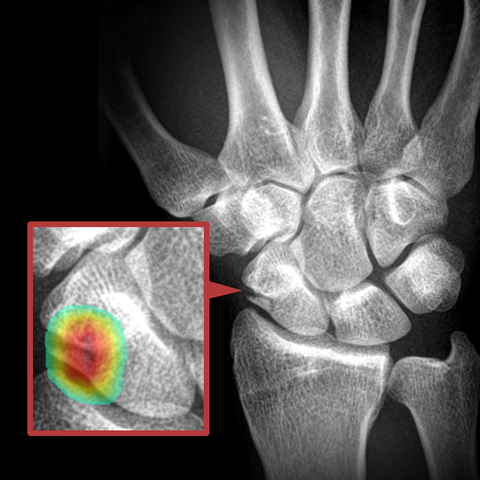AI tool to detect scaphoid fractures on wrist x-rays

Nils Hendrix and his colleagues from JBZ, JADS, and several Dutch hospitals developed an Artificial Intelligence (AI) system that can automatically detect scaphoid fractures, a common type of wrist fracture on x-rays. Scaphoid fractures typically occur when people fall on an outstretched hand. They make up 7% of all skeletal fractures encountered at the clinic. These fractures can be very subtle, but it is vital to diagnose them at an early stage, as the scaphoid may not heal properly if left untreated. A fractured scaphoid can damage the surrounding wrist bones and lead to permanent disability.
The proposed AI system employs two convolutional neural networks: one to locate the scaphoid and one to detect fractures. The AI system produces a score and indicates with a heatmap which region in the scaphoid it finds suspicious. This makes the tool more than a black box; the heatmap may help the radiologist to understand on what basis the AI tool computes its score, or recognize a processing failure. Hendrix compared the performance of the AI software with that of 11 radiologists, most of them musculoskeletal specialists, using a set of 190 x-rays with detailed follow-up to have certainty on whether the scaphoid was fractured or not. The system detected scaphoid fractures just as well as the radiologists, achieving an AUC score of 0.87 versus 0.83 for the average of the radiologists. The AUC score measures the probability that you would correctly select the fracture case if you are presented with a random fracture case and a random normal case from the set of 190 x-rays used in the study.
The study was published in Radiology: Artificial Intelligence on the 28th of April. A press release can be found here. The AI system is freely available on Grand Challenge, where you can upload an x-ray and see the results of the detection system in a web browser. Hendrix is now extending the AI tool so that it can also analyze multiple x-rays of the wrist taken from different directions. Several hospitals have already expressed interest to test the scaphoid fracture detector in clinical practice.
← Back to overview